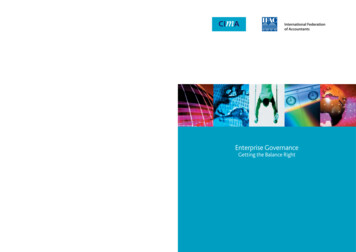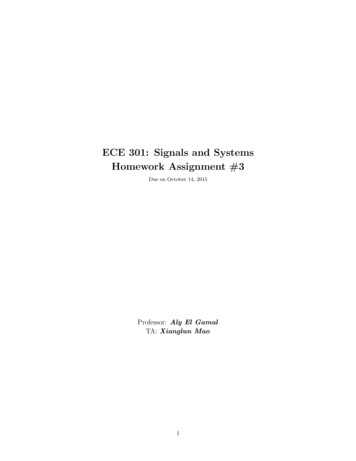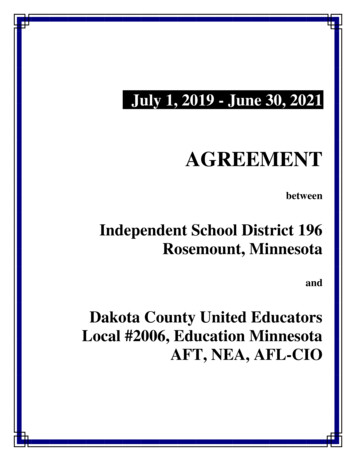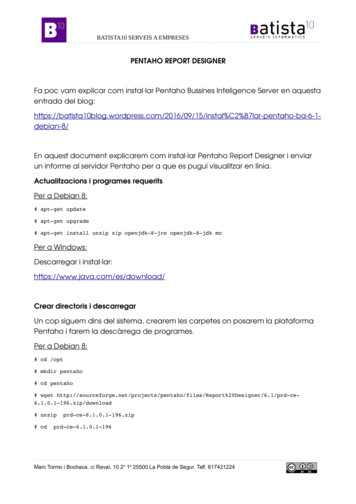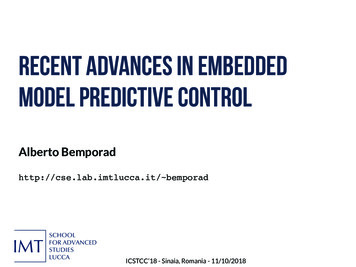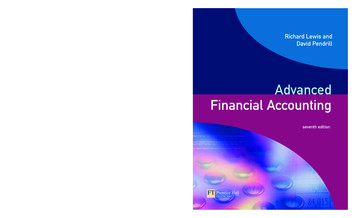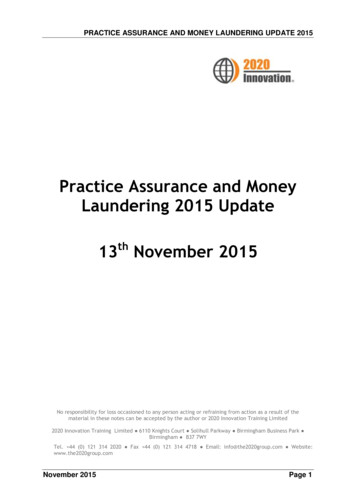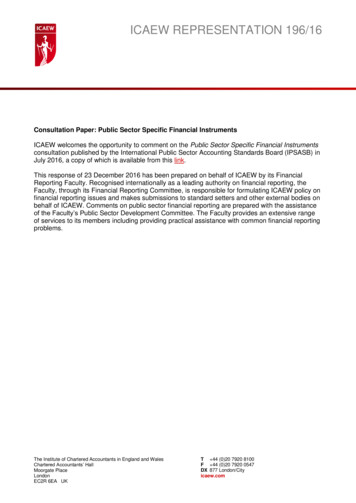
Transcription
ICAEW REPRESENTATION 196/16Consultation Paper: Public Sector Specific Financial InstrumentsICAEW welcomes the opportunity to comment on the Public Sector Specific Financial Instrumentsconsultation published by the International Public Sector Accounting Standards Board (IPSASB) inJuly 2016, a copy of which is available from this link.This response of 23 December 2016 has been prepared on behalf of ICAEW by its FinancialReporting Faculty. Recognised internationally as a leading authority on financial reporting, theFaculty, through its Financial Reporting Committee, is responsible for formulating ICAEW policy onfinancial reporting issues and makes submissions to standard setters and other external bodies onbehalf of ICAEW. Comments on public sector financial reporting are prepared with the assistanceof the Faculty’s Public Sector Development Committee. The Faculty provides an extensive rangeof services to its members including providing practical assistance with common financial reportingproblems.The Institute of Chartered Accountants in England and WalesChartered Accountants’ HallMoorgate PlaceLondonEC2R 6EA UKT 44 (0)20 7920 8100F 44 (0)20 7920 0547DX 877 London/Cityicaew.com
ICAEW is a world-leading professional accountancy body. We operate under a Royal Charter,working in the public interest. ICAEW’s regulation of its members, in particular its responsibilities inrespect of auditors, is overseen by the UK Financial Reporting Council. We provide leadership andpractical support to over 147,000 member chartered accountants in more than 160 countries,working with governments, regulators and industry in order to ensure that the highest standardsare maintained.ICAEW members operate across a wide range of areas in business, practice and the public sector.They provide financial expertise and guidance based on the highest professional, technical andethical standards. They are trained to provide clarity and apply rigour, and so help create long-termsustainable economic value.Copyright ICAEW 2016All rights reserved.This document may be reproduced without specific permission, in whole or part, free of charge andin any format or medium, subject to the conditions that: it is appropriately attributed, replicated accurately and is not used in a misleading context;the source of the extract or document is acknowledged and the title and ICAEW referencenumber are quoted.Where third-party copyright material has been identified application for permission must be madeto the copyright holder.For more information, please contact representations@icaew.comicaew.com
ICAEW Rep 196/16 – Consultation: Public Sector Specific Financial InstrumentsMAJOR POINTSSupport for the consultation paper1.We welcome the opportunity to contribute to this consultation on public sector specific financialinstruments. We support IPSASB’s broader strategy of focusing on public sector specificaccounting standards since that is where there is a sizable gap in accounting standardliterature. Furthermore, it is in the public interest that more governments adopt internationallyrecognised accounting standards and no doubt the attractiveness to adopt IPSASs willincrease with a wider coverage.2.We have a number of specific comments in response to the questions posed by IPSASB. Wepreface our responses to those questions with some observations on future developments andmeasurement issues.Future developments3.We have come across a number of standards that IPSASB are creating that would, had theybeen under IFRS, make use of Other Comprehensive Income (OCI). Financial instruments arean obvious example but employee benefits and social benefits accounting standards willfurther underline the need for IPSAS to include this category of income and expense. Weencourage IPSASB to remain aligned with IFRS as much as possible, which means thatexisting standards should be reviewed and updated more frequently than is currently the case.The lack of OCI in IPSAS is just one example of the misalignment.Measurement basis will divide opinion4.ICAEW published Measurement in Financial Reporting in 2006 as part of the thoughtleadership series Information for Better Markets Initiative. The report looks at a number ofdifferent measurement basis and presents a well-rounded discussion on the topic. A copy ofthis report can be found here and we commend this report to IPSASB. One of the observationsmade in the report is that the debate on measurement basis is very subjective and variousstakeholders with different needs will have opposing views. The IPSASB, as a standard setter,should clearly spell out the reasoning behind any final decisions in the basis for conclusions.5.Unlike consultations issued by the IASB, where there tends to be is a large investorcommunity responding, the consultations by IPSASB do not generally have the same diversityof respondents. This probably reflects the relatively narrow range of users of governmentaccounts at present. Government accounts should enable those responsible to be held toaccount, enable decision-making and provide greater transparency. Preparers however, maynot always share these objectives and it is in the public interest that IPSASB genuinelyconsider the information needs of all stakeholders, including potentially the general public,even if they are not currently regular users of government accounts.Clarifications of thought process6.A number of definitions are proposed in this consultation paper (CP). Whilst links to their originhave been made in the appendices, it is not obvious why this CP proposes to deviate fromtheir statistical framework origins. It would be useful if future consultations would make thismore explicit, since alignment with statistical frameworks, where appropriate, is desirable.7.Even slight deviations in wording may lead some preparers to interpret the definitionsdifferently compared to the statistical framework, leading to potentially different outcomes.3
ICAEW Rep 196/16 – Consultation: Public Sector Specific Financial InstrumentsRESPONSES TO IPSASB QUESTIONSPreliminary View 1:Definitions are as follows:a)Monetary authority is the entity or entities, including the central bank or adepartment(s) of the central (national) government, which carry out operations usuallyattributed to the central bank.b) Reserve assets are those external assets held by monetary authorities that are readilyavailable for balance of payments financing needs, intervention in the currency marketsto affect exchange rates and maintaining confidence in the currency and the economy.Do you agree with the IPSASB’s Preliminary View?8.The above definition of monetary authority is a departure from the definition provided byBalance of Payments and International Investment Position Manual – Sixth Edition (BPM6).Paragraph 6.66 of BPM6, as noted in paragraph A10 of the CP, provides a general definitionof reserve assets as follows:The functional concept of monetary authorities is essential for defining reserve assets.Monetary authorities encompass the central bank (which subsumes other institutional unitsincluded in the central bank subsector, such as the currency board) and certain operationsusually attributed to the central bank but sometimes carried out by other governmentinstitutions or commercial banks, such as government-owned commercial banks.9.Likewise, paragraph A9 in the CP provides the BPM6 definition of reserve assets. Thedefinition of reserve assets per BPM6 paragraph 6.64 is:Reserve assets are those external assets that are readily available to and controlled bymonetary authorities for meeting balance of payments financing needs, for intervention inexchange markets to affect the currency exchange rate, and for other related purposes (suchas maintaining confidence in the currency and the economy, and serving as a basis for foreignborrowing).10. We are not sure why IPSASB does not simply use the same definitions as per BPM6? Thedifferences are not large but nevertheless there is a risk that these differences might leadsome people, in our view, mistakenly, to believe that there is a difference in substance.11. As noted above, the CP has made reference to the definitions in BPM6 in paragraphs A9 andA10, yet these paragraphs don’t actually make it crystal clear that BPM6 paragraphs 6.64 and6.64 are definitions rather than just a description. IPSASB should, if they chose to depart fromstatistical frameworks, clearly spell out the specific reasons for any departures.Preliminary View 2:Definition is as follows:Currency in Circulation is physical notes and coins with fixed and determinable values thatare legal tender issued by, or on behalf of the monetary authority, that is, either that of anindividual economy or, in a currency union to which the economy belongs.Do you agree with the IPSASB’s Preliminary View?4
ICAEW Rep 196/16 – Consultation: Public Sector Specific Financial Instruments12. The definition proposed in this CP is an amalgamation of the BPM6 definitions of “domesticcurrency” (paragraph 3.95 of BPM6 and noted in paragraph A3 of the CP) and “currency”(paragraph 5.36 of BPM6 and noted in paragraph A4 of the CP):Domestic currency is that which is legal tender in the economy and issued by the monetaryauthority for that economy; that is, either that of an individual economy or, in a currency union,that of the common currency area to which the economy belongs.Currency consists of notes and coins that are of fixed nominal values and are issued orauthorized by central banks or governments.13. Whilst we would have preferred a closer alignment with the wording in BPM6, we accept theproposed definition.Preliminary View 3:Notes and coins (currency) derive value because they are legal tender and accepted as amedium of exchange and therefore serve the same purpose and function in the economy.As the purpose and function of notes and coins is the same, the IPSASB’s view is theaccounting treatment should be consistent for both (as noted in paragraph 3.12), with therecognition of a liability when issued.Do you agree with the IPSASB’s Preliminary View?14. We agree with the preliminary view on notes and coins above.Specific Matter for Comment 1:When the monetary authority assesses that a present obligation does not exist as a resultof the issuance of currency, because of the absence of a legal or non-legally bindingobligation (approach 1), it results in the recognition of revenue (approach 2), please explainyour view and your thoughts on what is the appropriate financial statement in which torecognize revenue:(i) Statement of financial performance; or(ii) Statement of net assets/equity?Please provide the reasons for your support of your preferred option, including theconceptual merits and weaknesses; the extent it addresses the objectives of financialreporting and how it provides useful information to users.15. We consider that the issuance of currency will, in most cases, lead to a legal or non-legallybinding obligation and find it difficult to imagine circumstances where this might not be thecase.16. Given that this CP has devoted quite a lot of space to this debate, we assume that IPSASBhave been made aware of some jurisdictions that do not recognise a liability. Perhaps IPSASBcould provide some examples of jurisdictions that do not recognise a liability upon issuance ofcurrency? Whilst the examples of paragraph 3.41 are interesting and useful in thinking aboutrecognition, adding empirical evidence would be welcome.17. Accounting standard setters should be mindful of the importance of setting standards thatmeet the needs for the majority of their stakeholders, whilst avoiding undue complexity.Accounting standards should not be designed to cater for every eventuality that may exist.5
ICAEW Rep 196/16 – Consultation: Public Sector Specific Financial InstrumentsThey should provide clear requirements for common types of transaction, including principlesthat may be applied to more unusual transactions and circumstances.18. At this stage of the consultation process we are sceptical that a future standard on currency incirculation should provide for the eventuality that no obligations exist. When preparers facelocal circumstances not envisaged by the standard, they should apply their judgement inarriving at a solution that is true and fair and provides users with the information they require.Preliminary View 4:Definitions are as follows:(a) Monetary gold is tangible gold held by monetary authorities as reserve assets.(b) Tangible gold is physical gold that has a minimum purity of 995 parts per 1000.Do you agree with the IPSASB’s Preliminary View?19. The definition of monetary gold is in paragraph 6.78 of BPM6 and noted in paragraph A7 of theCP:Monetary gold is gold to which the monetary authorities (or others who are subject to theeffective control of the monetary authorities) have title and is held as reserve assets.BPM6 goes on to say (but is not part of the definition): It consists of gold bullion (including goldcoins, ingots, bars with a purity of at least 995/1,000, and gold bullion held in allocated goldaccounts, regardless of the location of the account) and unallocated gold accounts with nonresidents that give title to claim the delivery of gold. Gold bullion is usually traded on organizedmarkets or through bilateral arrangements between central banks. To qualify as reserveassets, gold accounts must be readily available upon demand to the monetary authorities.20. This CP is proposing definitions that depart from BPM6 without apparent good reason. We feelthat the definitions in BPM6 are more robust since it refers to having title to the gold.Specific Matter for Comment 2:Should entities have the option to designate a measurement basis, based on theirintentions in holding monetary gold assets (as noted in paragraphs 4.5-4.6)?Please provide the reasons for your support for or against allowing an option to designate ameasurement basis based on intentions.21. Monetary gold is a reserve asset as recognised in the recommended definition in the CP.Reserve assets are assets that are readily available for balance of payments financing needs,interventions in the currency markets to affect exchange rates and maintaining confidence inboth currency and wider economy. A key element of reserve assets is to convey the strengthand flexibility of a government. We firmly believe that fair value provides the most objectivemeasure of a government’s reserve assets and that entities should not have the option todesignate a measurement basis. The fair value of gold will be the market value given the openand active market that exists.22. ICAEW issued Measurement in Financial Reporting as part of the thought leadership series onInformation for Better Markets Initiative. The publication explores different measurement basisand some wider issues. It notes that some financial analysts regard fair value as the onlyinformation relevant for financial decision-making.6
ICAEW Rep 196/16 – Consultation: Public Sector Specific Financial Instruments23. Some argue that market value introduces unnecessary volatility in the statement of financialperformance. In our view this ignores economic reality. Monetary authorities hold reserveassets to provide stability and liquidity for the functioning of financial markets. Users of theirfinancial statements would want to see any rises and falls in monetary gold values to measurethe performance of the monetary authority but to also assess the financial capacity. Thefinancial capacity to intervene in global markets can, in our opinion, only be measured byusing current values.24. The two main intentions of holding monetary gold as described in paragraph 4.5 would bothbenefit from having market value as the measurement basis. Intention two, which advocateshistoric cost, states that monetary gold is held for indeterminate period of time because itprovides confidence in the monetary authority’s financial strength. The monetary authorityshould be made to convey that strength in real terms, i.e. on current values rather than somearbitrary historic value when the gold price might have been very high. That could bemisleading.25. The argument that some monetary authorities may be restricted or prohibited from selling goldis not one which should influence this debate given that governments are uniquely placed tochange the laws if deemed necessary. There are many examples where a change in law tookplace to circumvent the long-standing status quo.26. The fair value of monetary gold is easy to obtain given the open and active gold bullion marketand will not face the same measurement difficulties that apply to some non-quoted financialinstruments. Thus fair value will be as reliable as historic cost, perhaps more so if recordshave not been maintained on the purchase of the gold. Furthermore, comparability willnaturally be increased by the removal of the option to designate measurement basis.Specific Matter for Comment 3:Please describe under what circumstances it would be appropriate to measure monetarygold assets at either:i. Market value; orii. Historical cost?Please provide reasons for your views, including the conceptual merits and weaknesses ofeach measurement basis; the extent to which each addresses the objectives of financialreporting; and how each provides useful information.If you support measurement based on intentions as discussed in SMC 4-1, please indicateyour views about an appropriate measurement basis for each intention for which monetaryauthorities may hold monetary gold, as discussed in paragraph 4.5 (i.e., intended to be heldfor its contribution to financial capacity because of its ability to be sold in the global liquidgold trading markets, or intended to be held for an indeterminate period of time).27. As previous debates on measurement basis have demonstrated, it will most likely be the casethat each measurement basis will have its supporters with often strongly entrenched views.However, as noted below and in response to SMC 2, we are in favour of applying market valueto monetary gold without the option to choose measurement basis.28. Monetary gold is held for its ability to store value and should be held at market value to reflectthat. Gold at market value would provide users with the most relevant information since itwould provide information on the financial capacity of the monetary authority. Furthermore, themarket value of gold, being based on current values, would be easily understood by users. We7
ICAEW Rep 196/16 – Consultation: Public Sector Specific Financial Instrumentsalso believe that market value would be most suitable for accountability and decision-makingpurposes.29. Given the role reserve assets play, we are of the opinion that these assets are effectively heldfor trading, otherwise they could not play a stabilising role. Assets that are held for trading aremeasured at fair value and we would not see a reason why monetary gold assets should betreated differently.30. Historic cost accounting does not recognise unrealised gains and losses and is often seen asa more conservative measurement basis. Whilst this is no doubt beneficial for some assets, itis not so for reserve assets which should not be undervalued or overvalued if they are to playa stabilising role in the economy. Historic cost would have the potential to send out wrongsignals and mislead the market. Lastly, it is unlikely that internal management decisions ongold would be made based on historic costs; market value would match the information thatmanagement uses.Preliminary View 5:Definitions are as follows:(a) The IMF Quota Subscription is the amount equal to the assigned quota, payable by themember on joining the IMF, and as adjusted subsequently.(b) SDR Holdings are International reserve assets created by the IMF and allocated tomembers to supplement reserves.(c) SDR Allocations are obligations which arise through IMF member’s participation in theSDR Department and that are related to the allocation of SDR holdings.Do you agree with the IPSASB’s Preliminary View – Chapter 5-1?31. The CP does not make it clear that the reason for the separate classification of SDRs as eitherassets (SDR Holdings) and liabilities (SDR Allocations) is that the IMF account for themseparately and the BPM6 requires that holdings and allocations are shown gross rather thannet (in paragraph 5.35 of BPM6 and noted in paragraph A14 of the CP). This point should behighlighted given that SDR Holdings and SDR Allocations are inter-related.32. BPM6 defines SDRs but only describes SDR holdings and SDR allocations. The SDRdefinition is in paragraph 5.34 of BPM6 and noted in paragraph A13 of the CP:SDRs are international reserve assets created by the IMF and allocated to members tosupplement existing official reserves.The last sentence of this paragraph goes on to say (but not as a part of the definition) that“SDR holdings represent unconditional rights to obtain foreign exchange or other reserveassets from other IMF members.” We are of the opinion that the definition of SDR Holdingswould be more complete if it included this explanation as it specifically relates to the SDR thatis an asset. A revised definition is proposed below (in mark-up):“SDR Holdings are international International reserve assets created by the IMF and allocatedto members to supplement existing official reserves and represent unconditional rights toobtain foreign exchange or other reserve assets from other IMF members.”33. We agree with the other definitions but we believe that an explanation as to how thesedefinitions were derived (based on statistical frameworks) would be useful.8
ICAEW Rep 196/16 – Consultation: Public Sector Specific Financial InstrumentsPreliminary View 6:The IPSASB view is that:(a) The IMF Quota Subscription satisfies the Conceptual Framework definition of an assetand should be recognized, with initial measurement at historical cost. Subsequentmeasurement may be at historical cost when the translated value of the quotasubscription equals the cumulative resources contributed to the IMF, when it does notit should be measured at net selling price.(b) SDR holdings satisfy the Conceptual Framework definition of an asset and should berecognized, with measurement at market value.(c) SDR allocations satisfy the Conceptual Framework definition of a liability and should berecognized, with measurement at market value.Do you agree with the IPSASB’s Preliminary View – Chapter 5-2?34. We agree with the preliminary view.35. We agree with the consultation paper views on using net selling price (equivalent to fair valueas per page 46 of the CP) when the translated value of the quota subscription does not equalthe cumulative resources contributed. As per paragraph 5.10, changes in a member’s currencydue to FX movements results in adjusting contributions to or from the IMF. Depending on thetiming of the adjusting contributions, it will be more likely that the translated value of the quotasubscription will not equal the cumulative resources contributed to the IMF. Thus, weanticipate the net selling price playing a more prominent role. Should the quota be equal tocontributions then historical cost and fair value are in fact materially the same.36. We agree with the preliminary view that SDR Holdings are assets and SDR Allocationsliabilities. Furthermore, we also agree that SDR Holdings and Allocations are monetary itemsand that fair value is the most appropriate measurement basis. In the UK, these are measuredat fair value through profit and loss.9
12. The definition proposed in this CP is an amalgamation of the BPM6 definitions of "domestic currency" (paragraph 3.95 of BPM6 and noted in paragraph A3 of the CP) and "currency" (paragraph 5.36 of BPM6 and noted in paragraph A4 of the CP): Domestic currency is that which is legal tender in the economy and issued by the monetary
